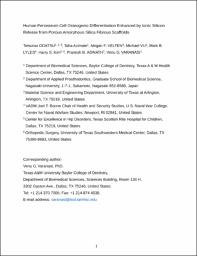
ATTENTION: The works hosted here are being migrated to a new repository that will consolidate resources, improve discoverability, and better show UTA's research impact on the global community. We will update authors as the migration progresses. Please see MavMatrix for more information.
Show simple item record
| dc.contributor.author | Odatsu, Tetsurou | |
| dc.contributor.author | Azimaie, Taha | |
| dc.contributor.author | Velten, Megan F. | |
| dc.contributor.author | Vu, Michael | |
| dc.contributor.author | Lyles, Mark B. | |
| dc.contributor.author | Kim, Harry S. | |
| dc.contributor.author | Aswath, Pranesh B. | |
| dc.contributor.author | Varanasi, Venu | |
| dc.date.accessioned | 2019-05-31T18:30:34Z | |
| dc.date.available | 2019-05-31T18:30:34Z | |
| dc.date.issued | 2015-01-28 | |
| dc.identifier.citation | Odatsu T, Azimaie T, Velten MF, Vu M, Lyles MB, Kim HK, Aswath PB, Varanasi VG 2015. Human peri- osteum cell osteogenic differentiation enhanced by ionic silicon release from porous amorphous silica fibrous scaffolds. J Biomed Mater Res Part A 2015:103A:2797–2806. | en_US |
| dc.identifier.issn | 1552-4965 | |
| dc.identifier.uri | http://hdl.handle.net/10106/28191 | |
| dc.description | The original publication is available at https://onlinelibrary.wiley.com/doi/abs/10.1002/jbm.a.35412 | en_US |
| dc.description.abstract | **Please note that the full text is embargoed** ABSTRACT: Current synthetic grafts for bone defect filling in the sinus can support new bone formation but lack the ability to stimulate or enhance osteogenic healing. To promote such healing, osteoblast progenitors such as human periosteum cells must undergo osteogenic differentiation. In this study, we tested the hypothesis that degradation of porous amorphous silica fibrous (PASF) scaffolds can enhance human periosteum cell osteogenic differentiation. Two types of PASF were prepared and evaluated according to their densities (PASF99, PASF98) with 99 and 98% porosity, respectively. Silicon (Si) ions were observed to rapidly release from both scaffolds within 24 h in vitro. PASF99 Si ion release rate was estimated to be nearly double that of PASF98 scaffolds. Mechanical tests revealed a lower compressive strength in PASF99 as compared with PASF98. Osteogenic expression analysis showed that PASF99 scaffolds enhanced the expression of activating transcription factor 4, alkaline phosphatase, and collagen (Col(I)α1, Col(I)α2). Scanning electron microscopy showed cellular and extracellular matrix (ECM) ingress into both scaffolds within 16 days and the formation of Ca‐P precipitates within 85 days. In conclusion, this study demonstrated that PASF scaffolds enhance human periosteum cell osteogenic differentiation by releasing ionic Si, and structurally supporting cellular and ECM ingress. © 2015 Wiley Periodicals, Inc. J Biomed Mater Res Part A: 103A: 2797–2806, 2015. DOI: 10.1002/jbm.a.35412 | en_US |
| dc.language.iso | en | en_US |
| dc.publisher | Society for Biomaterials; Nihon Baiomateriaru Gakkai; Australian Society for Biomaterials; Korean Society for Biomaterials, Wiley | en_US |
| dc.subject | Si | en_US |
| dc.subject | Scaffold | en_US |
| dc.subject | Periosteum cell | en_US |
| dc.subject | Runx2 | en_US |
| dc.subject | Osteocalcin | en_US |
| dc.title | Human Periosteum Cell Osteogenic Differentiation Enhanced by Ionic Silicon Release from Porous Amorphous Silica Fibrous Scaffolds | en_US |
| dc.type | Article | en_US |
Files in this item
- Name:
- VVaranasi_human_periosteum.pdf
- Size:
- 442.4Kb
- Format:
- PDF
This item appears in the following Collection(s)
Show simple item record


